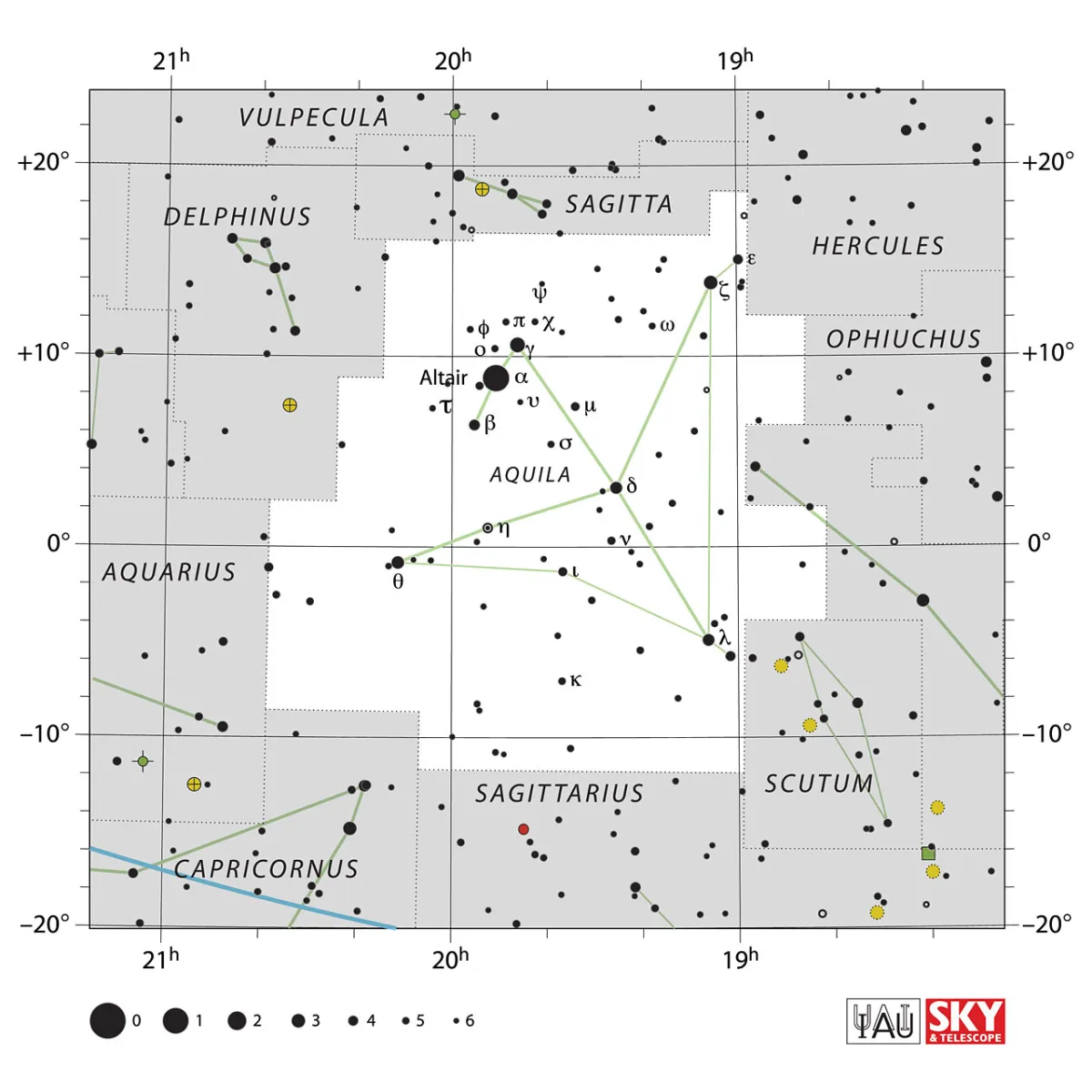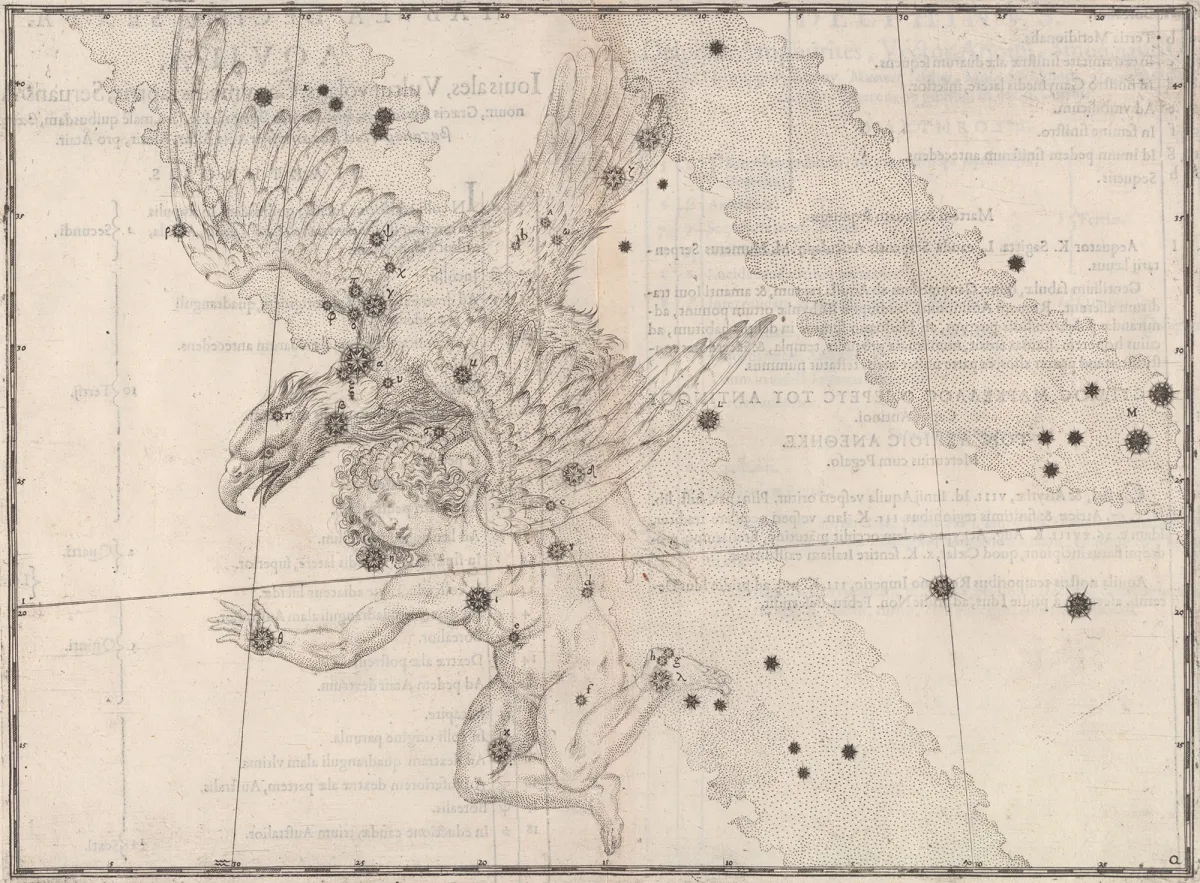Constellation Aquila (Eagle)

Properties
Aquila is one of the summer constellations. Its brightest star, Altair, together with Deneb (α Cygni) and Vega (α Lyrae), marks the well-known Summer Triangle. Aquila lies in the band of the Milky Way south of Cygnus, separated by Sagitta. The star Altair is easy to recognize by its two fainter companions (β and γ Aquilae), which flank it like bodyguards on the right and left; they bear the names Alshain and Tarazed, both derived from the Persian name of the constellation, Shahin tara zed (star-studded falcon). This formation is the most distinctive feature of this constellation, which contains star-rich regions, especially near the southwestern border with Scutum. The area of Aquila is 652 square degrees, and it culminates at midnight around July 12. [9, 15]
| α Aql | Altair, Atair |
| β Aql | Alshain, Alschairn |
| γ Aql | Tarazed, Reda |
| ε Aql | Deneb El Okab, Deneb |
| ζ Aql | Deneb El Okab, Deneb |
| IAU Name | Aquila |
| IAU Genitive | Aquilae |
| IAU Abbr. | Aql |
| English Name | Eagle |
| Culmination at local midnight | 16 July |
| Season (Latitude +0.0°) | March … December |
| Right Ascension (J2000.0) | 18h 41m 18s … 20h 38m 44s |
| Declination (J2000.0) | -11° 51' 59" … +18° 41' 18" |
| Area | 652 deg2 |
| Neighbours (N↻) | Sge, Her, Oph, Ser, Sct, Sgr, Cap, Aqr, Del |
Deep-Sky Object Descriptions
Catalogues
Mythology and History
A constellation from ancient times. It had been known as the Adler for over 3000 years. In Greek mythology, the eagle stole Antinous, one of the suitors of Penelope, the wife of Odysseus, and brought him to Olympus, where he became a servant of the gods. The eagle was always at Zeus' side in his long battle against the titans for control of the universe. His job was to carry Zeus' thunder arrows so that he could use them to kill the titans. [73]

Aquila also played a role in domestic affairs on Mount Olympus, the seat of the gods. One day the gods needed a new cup carrier to serve them fresh nectar. But this task could only be done by the most beautiful youth on earth. The eagle was sent out to find a new cup-bearer. When he brought the stately Trojan prince Ganymedes to Zeus, the king of the gods was so delighted that he gave the eagle a place under the stars. [73]
An eagle also appears in the Hercules legend. On the way to the tree with the golden apples of eternal youth on the western edge of the earth, Hercules passed a lonely place in the Caucasus. Prometheus, a son of the sky god Uranus and mother earth, lay there forged on a rock. This was the punishment of the gods, since Prometheus created people out of clay for whom he is said to have later stolen the fire from heaven. An eagle came by every day, tore open its body with its pointed, crooked beak and ate at its liver. When Hercules saw this gruesome spectacle, he shot the eagle with an arrow and thus freed Prometheus - at least for a short time - from his torment. An arrow still flies over the constellation Aquila today - did Hercules not hit it after all? [20]
Another version of the first episode is followed by the name The Eagle with the Antinous or Servans Antinoum: The favourite boy of Emperor Hadrian (2nd century AD), an ideal of youthful beauty, was drowned in a river, it is not known whether it was an accident or he drowned himself in order to obtain a long life for his patron Hadrian through this sacrificial death. Shortly afterwards Zeus sent his eagle to lift Antinous up to the starry sky. Many star maps show the boy in the clutches of the eagle and for some time he was listed as a separate constellation south of Aquila. [20, 62]